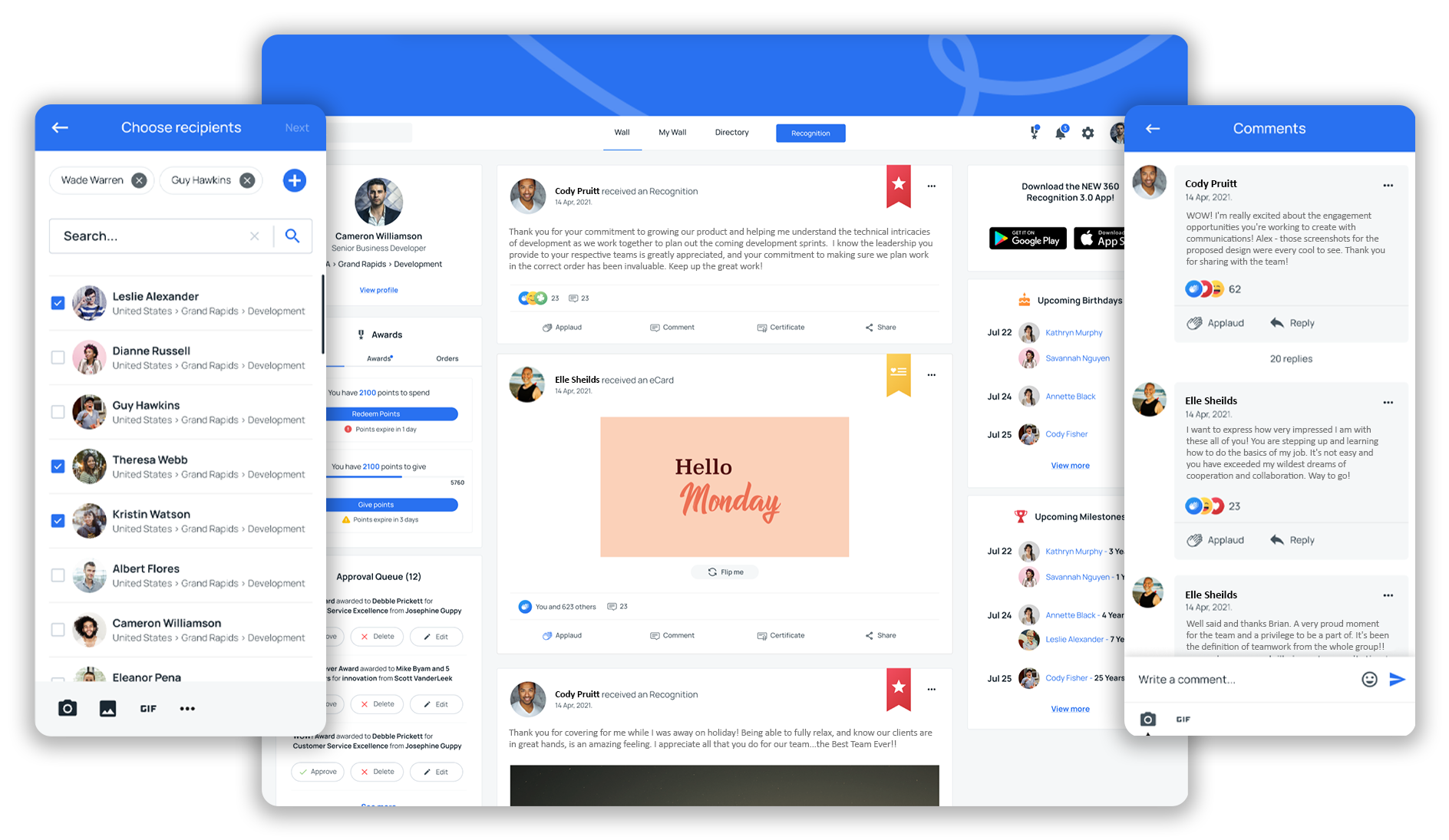October 24, 2024

A successful recognition program doesn't happen by chance or even by well-meaning but directionless efforts from your HR team - it becomes a reality when you take into account the employee recognition criteria that define an effective program.
After decades in the employee recognition industry, we've learned exactly what it takes to build a recognition program that results in that culture of recognition you've been aiming for. Let's talk about what best practices make up a strong recognition and rewards program.
Key takeaways
- Some of the key employee recognition criteria to look for in a successful program include the opportunity to celebrate employees in a variety of ways, both top-down and peer-to-peer recognition, alignment with company values, and individualized recognition experiences.
- Digital employee recognition platforms make it easier for employees to give and receive recognition. Many can be personalized to meet the specific needs of your organization.
- Measuring your recognition program's effectiveness requires looking at KPIs including participation rates, employee engagement, and employee retention.
What makes employee recognition programs effective?
Let's start with the obvious - your employee recognition program can't be effective if you don't have one. A 2023 study from Gallup found that only 34% of employees agree that their employer has a recognition program. Of that one-third, only 13% of employees would rate their employee recognition program as excellent. The bar is low, unfortunately.
Tolstoy wrote, “All happy families are alike; every unhappy family is unhappy in its own way." Like those happy families, all the best employee recognition programs have a few best practices in common. Here are some of the most common characteristics we've seen in thriving recognition programs.
1. Social recognition
The most memorable form of recognition isn't a monetary prize or trip - it's public recognition or acknowledgment. Your recognition program should include opportunities for tailored social recognition. Not everyone wants their 10 minutes of fame in front of a hundred colleagues, so utilize a mixture of social recognition opportunities, such as:
- Social media shoutouts
- Mentions in staff meetings
- Slack shoutouts
- Mentions in the company newsletter
- Mentions on a wall of fame
2. Peer-to-peer recognition
Research from Quantum Workplace found that employees are nearly 3 times more likely to be highly engaged when they receive recognition at least once a week from their peers. Peer-to-peer recognition has a positive impact on several aspects of the employee experience.
First, it allows for the frequent appreciation that most workers desire. Instead of being celebrated by a single manager, employee appreciation can come from a few dozen peers. This multiplies recognition opportunities tenfold.
Second, an employee's colleagues often notice the small, everyday actions that contribute to the team's success, including moments that their supervisors may never be privy to.
Third, peer recognition moments often occur more naturally than top-down praise. Recognition organically becomes a key component of the workplace culture rather than something reserved for performance reviews.
3. Top-down recognition
While there's a lot of value in peer recognition, top-down appreciation also has a significant impact on the employee experience. 28% of employees say that their most memorable recognition comes from their manager, and 24% would say it comes from a high-level leader or CEO. Executives and managers should set a goal to provide regular feedback to employees they supervise.
4. An emphasis on self-improvement

Remember, don't encourage employees to compete against one another - that's a one-way ticket to resentment. Instead, engage employees in working to meet goals and compete against their former selves.
A perfect example is the approach many companies take to wellness challenges such as step challenges. Sure, individuals may be competing to take the most steps and defeat their colleagues, but many challenges are also designed to encourage participants to reach a minimum number of steps each day.
Even if someone doesn't land on the leaderboard, they can be proud that their step count steadily increased or that they met their step goal every day for the past week.
5. Timely recognition
Timely recognition involves two factors:
- Recognition should be given as soon as possible after a win AND
- Recognition should happen frequently.
Gallup recommends that employee recognition occur every seven days. In most organizations, this can only be a reality if you offer multidirectional recognition opportunities, where praise comes from both peers and managers.
Hilton's Catch Me At My Best program is a great example of an emphasis on timeliness. It is described as a "spontaneous recognition program aimed at catching Team Members in the act of delivering exceptional hospitality." The immediate recognition communicates to employees that their efforts are seen and valued.
6. Alignment with company values and goals

A recognition program that aligns with your organization's mission will help shape the recognition culture you want to have and encourage desired behaviors in your employees.
That sounds great, but what does it look like to put this into practice?
At Terryberry, employees can select from categories of recognition when they celebrate one another, and each category aligns with our core values: above-and-beyond, courage, customer-centric, innovation, and collaboration.
In a company that values learning and growth, there might be an emphasis on celebrating employees who attend professional development, complete additional training, and master new skills.
7. Leadership buy-in
Having a supportive leadership team goes a long way in sustaining the spirit (and budget) you need for your recognition program.
Acquiring and maintaining leadership buy-in requires frequent and transparent communication about the goals of your program and what results you're seeing from your recognition efforts. Focus on the ROI such as increases in productivity levels, employee morale, employee motivation, job satisfaction, and business outcomes.
In successful recognition programs, buy-in from your leadership team can look like:
- allocating a reasonable employee recognition budget to the program
- active participation in recognizing employees and celebrating achievements
- communicating the value of appreciation
- taking the time to train managers on effectively delivering recognition
- seeking feedback on the program and making adjustments as needed
8. Storytelling

Research published by Forbes highlights storytelling as one of the most powerful employee recognition practices. Storytelling achieves two things: it publicly celebrates people who excel and it acts as a model about what success looks like within your organization.
Include stories in company newsletters and post on social media about employees who have won an award, showcasing individuals both to the company and the general public.
9. Personalized recognition experiences
In his article "Why Employee Recognition Doesn’t Work: My Confession As A So-Called Expert," author and consultant Todd Nordstrom discusses a critical point: you can't truly encourage and inspire employees unless you're focusing on the values that they hold dear. When you get to know what topics and experiences interest the individual, you can provide personalized recognition and recognition experiences that deliver.
Use an employee survey to find out your employees' preferences, then consider adding this fact-finding mission as part of your onboarding process to make sure you have relevant information for every employee in your organization. Include questions about:
- what type of recognition they prefer
- the setting in which they're most comfortable receiving recognition
- reward preferences such as a monetary bonus, PTO, gift cards, etc
- important dates such as their birthday
- favorite foods, restaurants, and stores
- dietary restrictions and allergies
10. Celebration of milestones

Almost 38% of new hires leave within the first year of a new job. When employees make it to the 1, 3, and 5 years mark, that's definitely something worth celebrating.
However, your recognition program should also observe milestones other than work anniversaries. Most companies spend an average of 1-2% of payroll on employee recognition, but research has shown that 87% of recognition programs focus on one thing: tenure.
Here are some other milestone awards you might consider giving employees:
- work anniversaries (1, 3, 5, 10, then every 5 years of service)
- promotions
- project completions
- performance achievements
- team achievements
- health and safety achievements
- new certifications
- completion of professional development programs
11. Celebration of employees as individuals
Well-rounded recognition programs celebrate well-rounded people. Meisha-ann Martin, a director of human analytics and research, emphasizes the need to recognize people not just for the work they do, but for who they are as a person. Create recognition opportunities to highlight the specific skills and strengths of each individual.
Recognition doesn't have to be restricted to work-related achievements, either. Shoutout employees for success and milestones in their personal lives, such as completing a degree, getting engaged, or running a marathon. Let your employees know you see them as whole people, not just employees.
12. Opportunities to celebrate both big and small wins

Of employees who say they have had great recognition experiences, 72% agree that they are frequently recognized for the 'little things.' Small victories are just as crucial to your company's overall success but can be overlooked by those big flashy milestones. Being recognized for small wins keeps the motivation flowing as employees work toward larger goals.
Here are a few small but meaningful victories you could celebrate:
- meeting a deadline
- volunteering for a project
- helping out a colleague
- sharing new ideas during a meeting
- delivering quality work
- successfully collaborating with different departments
- consistently performing their regular duties without incident
13. Tech utilization
Technology can make employee recognition programs more efficient, accessible, and engaging. There are several benefits to adapting a digital employee recognition platform.
Technology allows for real-time feedback. You don't have to see other colleagues in-person to congratulate them after a killer presentation, which is especially helpful for hybrid or fully remote teams.
Technology helps you gamify recognition. Incorporating game-like elements such as badges and points can make recognition more engaging for most employees.
Technology offers mobile access. The convenience factor of being able to give and receive appreciation anytime, from anywhere, can increase participation rates - especially for remote or deskless employees.
Technology centralizes employee recognition. A single digital platform can be used to give and receive recognition, redeem points to reward employees with prizes, and track recognition metrics. Many platforms integrate with other systems such as communication tools and performance management tools to simplify the employee recognition experience.
Key performance indicators to measure your program's effectiveness
Making decisions about the future of your recognition program can be challenging when you feel personally invested in the outcome. Data provides an unbiased view on if your employee recognition program is engaging employees and can help you pinpoint areas that could benefit from some tweaks or a major overhaul.
Here are some key performance indicators you should consider.
Participation

The most straightforward KPI for your recognition program is program usage and participation. Monitor logins, recognition sent and received, and rewards redeemed to determine what percentage of your employees are engaging with the program.
Low participation rates don't necessarily mean your program is a flop. Instead, dig into the data to determine where the recognition gaps are so you can decide what tweaks need to be made. A few participation-related data points you might look at include:
- which department, job roles, or demographic groups most frequently utilize the program
- what types of recognition are rewarded
- what aspects of your recognition platform aren't being used
Award redemption rate
The award redemption rate is another indicator of employee interest and engagement with your recognition program. A low redemption rate suggests that employees don't find your rewards appealing, whereas a high rate communicates that the rewards are interesting and relevant.
You can track redemption rates over time to assess whether interest in your program is growing, stagnant, or declining. It's also helpful to monitor which rewards are most frequently chosen so you can refine your program and replace unpopular options with rewards that better resonate with participants.
Manager participation rate
This metric is one indicator of how much leadership buy-in your program has. Low rates may indicate the need for additional training about the value of employee recognition and how to deliver effective recognition.
You can also track how often managers recognize their team members compared to peers and assess the correlation between manager participation and employee engagement and retention rates within their department.
Employee engagement

Employee engagement is an intangible quality that can be difficult - if not impossible - to measure without directly asking employees. Pulse surveys are typically used to gather anonymous feedback relating to employee engagement levels.
To assess employee engagement and the employee recognition experience, include pulse survey questions such as:
- How satisfied are you with your job? (1 - Not satisfied, 5 - Very satisfied)
- How would you rate the support you receive from your manager in your role? (1 - Not supportive, 5 - Very supportive)
- How effective do you find communication within your team? (1 - Not effective, 5 - Very effective)
- How often do you receive appreciation for your work? (1 - Rarely, 5 - Very often)
- How satisfied are you with the recognition you receive for your contributions? (1 - Not satisfied, 5 - Very satisfied)
- How easy is it to recognize your colleagues using the provided tools or platforms? (1 - Very difficult, 5 - Very easy)
It's also helpful to include open-ended questions such as:
- What specific opportunities for growth or development would you like to see offered?
- How would you describe the collaboration and communication within your team?
- Can you describe a time when you felt particularly recognized or appreciated at work? What made it meaningful?
- How do you think we can encourage more peer recognition in our workplace?
- What do you think are the biggest barriers to recognition within our organization?
- What improvements would you suggest for our employee recognition program?
Terryberry's employee survey platform offers both engagement surveys and pulse surveys that can help you collect feedback for data-driven decisions regarding the next steps for your employee recognition program.
Company culture
Like employee engagement, company culture can be harder to measure than KPIs like sales goals and employee retention. You can use surveys to assess company culture and employ additional methods such as:
- hosting one-on-one interviews and focus groups
- observing employees across a variety of departments
- providing anonymous feedback channels
- analyzing feedback from exit surveys
- analyzing feedback on platforms such as Glassdoor or Indeed
Employee retention

A recognition-rich culture creates a positive work environment which can help improve employee morale, employee motivation, and employee satisfaction.
Data collected from 2022 to 2024 shows that well-recognized employees are 45% less likely to have left their job after two years, and organizations that rank in the top 20% of businesses with recognition-rich cultures experience 31% lower turnover among their employees.
To measure the impact of recognition on employee retention, analyze turnover rates before and after you implement or enhance your recognition program. During exit interviews, include questions about the role of recognition in employees' decisions to leave the organization.
It's never been easier to design a successful recognition program
The employee recognition criteria that goes into building an effective recognition program may feel daunting, but you don't have to approach the task alone. When you partner with Terryberry, you'll have access to a customizable platform you can use to engage employees through recognition, rewards, wellness programs, and surveys. Contact us to learn more or get started.


